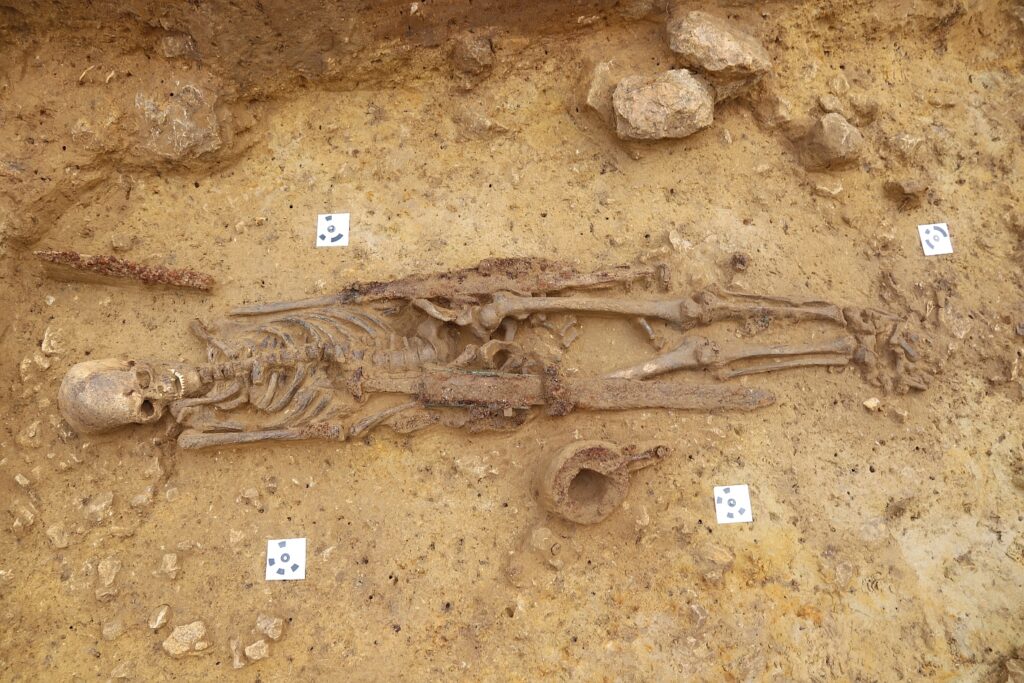Franconian warrior provides insights into the fashion of the Middle Ages
Press release from 4 August 2023
Since 2015, archaeologists from the Kaiserpfalz Research Centre have been investigating the early medieval burial ground in the area between Rotweinstraße and Stevenagestraße. The current season will be the last for the time being, as the campaign ends this year. The researchers were all the more delighted when the burial ground once again offered a big surprise in June: in the middle of the numerous graves that had already been plundered in the Middle Ages, the burial of a man came to light who had been buried untouched in the earth for over 1300 years.
Generally, Merovingian graves on the Rotweinstraße can be easily recognised by the darker filling of the grave pit. In this case, no discolouration was visible and the entire area was heavily disturbed by neighbouring graves, making it difficult to interpret. ‘When the edge of a shield hump came to light, it wasn’t clear at first whether it belonged to one of the disturbed graves or to an as yet undiscovered one,’ explains excavation manager Christoph Bassler. ‘So we continued to dig carefully until it became clear that we had actually discovered a completely untouched grave between two robbed burials, which the grave robbers must have overlooked for some reason.
Valuable insights into customs and fashion
If the looters had known back then what they were missing, they would probably have been very annoyed. Because the burial with the finding number 447 literally has it all: the man laid to rest in it was armed to the teeth. His most valuable artefact is undoubtedly a spatha, a double-edged sword that was placed next to the dead man’s right arm. ‘The length of the spatha blade is about 75 cm, the whole sword including the hilt and pommel is about 93 cm long,’ reports Bassler. ‘The blade is even still slightly flexible, which indicates that it is in an exceptionally good state of preservation,’ says the early medieval expert happily. Other parts of the sword are also still present, provided they were made of metal, such as elements of the bronze scabbard and fragments of the suspension or belt: everything is still there as it was laid down centuries ago, from which the researchers can gain valuable insights into burial customs and fashion at the time. The close-fitting and slightly raised shoulders of the skeleton – the so-called coffin position – prove that the deceased was buried in a wooden coffin, of which no remains have survived.
In addition to the sword, the man also had a massive broadsax, of which the blade and the bronze rivets of the scabbard were found. Such a sax, a type of heavy and short slashing sword, is not uncommon in graves from this period. However, this man also had another heavy knife and a lance, the tip of which has been preserved. Together with the shield, the deceased had practically every type of weapon in use at the time, with the exception of a bow. Despite his martial equipment, the warrior from grave 447 was not a professional soldier in the modern sense, as there was no standing army in the early Middle Ages. Instead, every free man had to follow his leader when he was called to battle. He had to provide his own equipment. In this respect, the impressive arsenal of weapons suggests that its owner must have been correspondingly wealthy during his lifetime.
Burial objects and bones are analysed
All the grave goods from the tomb have now been handed over to a conservator. Among other things, the further analyses are intended to narrow down the preliminary dating of the grave. So far, stylistic features such as the flat shield boss with a wide rim and the massive sax point to the 7th century. However, many details of the ornamentation, such as the silver inlays, so-called inlays, will only be revealed once the thick layers of rust have been removed. Head of Department Eveline Breyer is also hoping to gain new insights from the ongoing analyses: ‘This extraordinary find is another piece of the puzzle for our picture of the city in the early Middle Ages. Like the many other discoveries on the Rotweinstraße, it will help us to better understand and visualise this oldest society in Ingelheim.’
The results of the anthropological bone analyses could also contribute to this. It is still unclear what caused the death of the man, who was around 30 to 40 years old. Disease or violence are possible causes. In view of the warlike appearance of the grave furnishings, an injury sustained in battle would at least come as no surprise to anyone.
